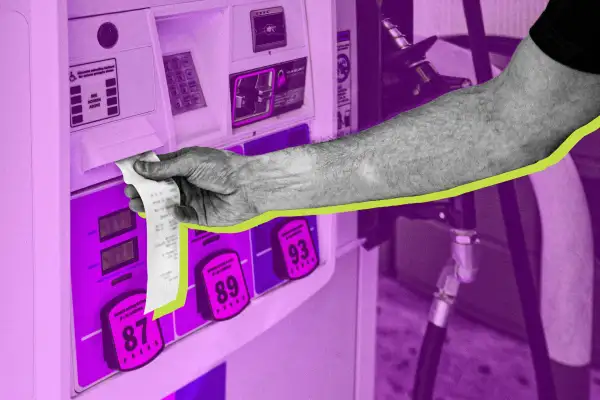Why Gas Prices Could Fall Below $3 This Summer, According to Experts

Some forecasters say that pump prices are poised to drop below $3 in the coming weeks. Gas prices normally climb around this time of year, frequently peaking near Memorial Day or during the summer months, but cheaper oil is keeping costs down.
In the spring, the demand for gas rises as more drivers get out on the roads, enjoying pleasant weather. That trend — combined with the annual transition to more expensive summer blend fuel — usually translates to higher gas prices.
However, fluctuations in the cost of crude oil can cause gas prices to decrease or stay flat at times of the year when they usually go up, which is what's happening now. (Crude oil accounts for 54% of what you pay for a gallon of gas.)
Oil was trading at around $57 per barrel on Monday after falling to the lowest level in four years last week, according to the West Texas Intermediate measure. Fears of oil surpluses have caused prices to drop. Over the weekend, the Saudi Arabia-led OPEC+ group announced an oil production increase that will take effect in June.
Why gas prices could soon fall
The national average for a regular gallon of gas is $3.12, and the cost has stayed within 15 cents of that level all year so far, according to the price comparison app GasBuddy. The current price is 50 cents lower than the average a year ago.
"While gasoline inventories have been tightening due to ongoing refinery maintenance — which has limited how much gas prices have fallen in response to lower oil — refinery output is expected to rise soon," Patrick De Haan, head of petroleum analysis at GasBuddy, said in a report Monday. "As maintenance wraps up, we could see an increase in gasoline supply and a national average that may soon dip below $3 per gallon."
Average gas prices are already well below $3 in much of the South, where proximity to refineries usually means lower prices. Mississippi ($2.62), Louisiana ($2.67) and Tennessee ($2.69) have the cheapest gas. Prices out West are pulling up the national average. California ($4.70), Hawaii ($4.41) and Washington ($4.20) have the most expensive gas.
According to a separate report Monday from the Energy Information Administration, California's jarringly high gas prices are a product of "state taxes and fees, environmental requirements, special fuel requirements and isolated petroleum markets." Residents pay 90 cents per gallon in taxes and fees alone, according to the report.
Conservative groups in Washington are putting political pressure on Democrats in states like California to lower their gas prices, while also exploring options for reducing or eliminating the federal gas tax — every time you fill up, you're paying 18.4 cents per gallon to the U.S. government. Last week, House Republicans scrapped an idea to impose a $20 annual fee on all cars to try to help pay for such a tax cut. Lawmakers are now looking at a possible $250-per-year fee that would apply to electric vehicles.
Lower gas prices are providing some relief for consumers, even in California where folks were paying $5.35 on average a year ago. But while experts say even cheaper gas is coming soon, the weakness in oil could have undesirable long-term effects on U.S. production.
"OPEC+’s increase of over 400,000 barrels of oil production starting in June against a backdrop of global uncertainty and some weakness sent oil prices dropping," De Haan said. "While the short term could see U.S. gas prices struggling to maintain a $3 per gallon national average, the U.S. oil rig count fell three more rigs and is now 21 rigs lower than a year ago, showing U.S. producers are pulling back on drilling activity."
More from Money:
5 Best Auto Refinance Companies of 2025
